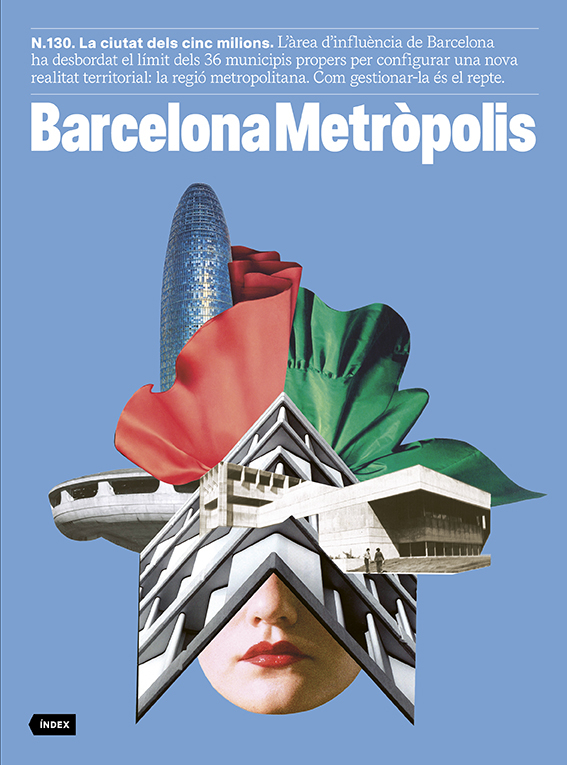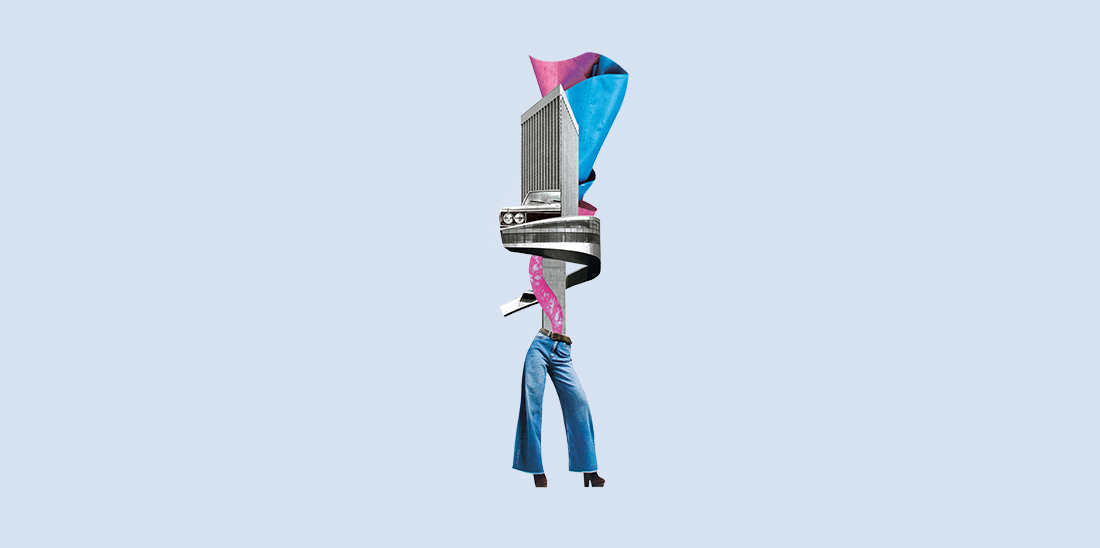
The Barcelona metropolitan region is undergoing a phase of counterurbanisation. While urban-to-rural migrations remain a minority phenomenon, they are on the rise, driven by the COVID-19 pandemic. The housing crisis, particularly acute in major cities, is fuelling these residential shifts, expected to persist with significant intensity. While presenting an opportunity for the revitalisation of rural areas, they also come with risks and paradoxes.
The COVID-19 pandemic wrought profound changes on contemporary societies at multiple levels, influencing residential mobility patterns in major urban centres. Measures to curb infections and restrictions from lockdowns heightened the allure of less densely populated areas, boasting greater access to nature. In a short span, demographers worldwide noted a surge in migrations from metropolises to rural regions during the pandemic, spanning diverse international contexts.
In any case, it was a relatively modest phenomenon. It did not cause a major upheaval in the prevailing patterns of residential mobility, nor did it significantly alter the demographic structure of urban areas. However, in rural regions, where populations are smaller and more susceptible to sudden demographic shifts, the influx of urban residents was indeed noticeable.
Initially viewed as a temporary trend, the first analyses of post-pandemic data have shown that migration to rural areas continues.[1] The Barcelona metropolitan region is no exception. In the “city of five million”, the trend of counterurbanisation has persisted through the pandemic, leaving open the question of whether it will become a lasting fixture in the years ahead.
Explanatory factors behind urban-rural migration
The processes of metropolitanisation and urban expansion often follow a pattern of centralisation or concentration (where the most populated areas grow), dispersion-suburbanisation (stagnation of densely populated cores and the expansion of less dense areas) and decline (resulting in a decline in population in the most heavily populated areas). These processes need not unfold in a strictly sequential or linear manner; rather, they may alternate or coexist within the same urban landscape, reflecting diverse demographic trends simultaneously.
Counterurbanisation is indeed one of these more complex processes,[2] involving a deconcentration of metropolitan populations characterised by a shift in the relationship between the size of territories and their net migration. This occurs when the migratory movements from less populated areas within a metropolitan region outweigh those from more densely populated ones, considering solely internal migrations. This is precisely the scenario that has become more pronounced in recent years within the Barcelona metropolitan region (graph 1), a trend that, interestingly, had also been observed in other European metropolises just prior to the pandemic.[3]
![Graph 1. Net Migration by Degree of Urbanisation. Metropolitan Region of Barcelona, 2007-2021. Source: INE [Spanish National Statistics Institute], Residential Variations Statistics, 2007-2021. Graph 1. Net Migration by Degree of Urbanisation. Metropolitan Region of Barcelona, 2007-2021. Source: INE [Spanish National Statistics Institute], Residential Variations Statistics, 2007-2021.](https://www.barcelona.cat/metropolis/sites/default/files/styles/img_central/public/contraurbanitzacio_bncm130_wec_eng_01.png?itok=SdczLwx4)
There are several reasons behind this resurgence in urban-to-rural migrations, extending beyond the impact of the pandemic. For some individuals, in line with the neo-ruralist movement, the primary motivation for leaving city life behind and relocating to the countryside is the aspiration to develop alternative and self-sufficient ways of living, aiming to break away from the dominant urban lifestyle model. This movement, which emerged in the 1970s, has evolved over time towards positions that are less radical and more aligned with environmentalism, emphasising the importance of direct engagement with nature and its conservation. According to certain authors, this demographic profile is gaining traction within the current context of systemic crises affecting contemporary societies.[4]
Others take a more pragmatic approach, often driven by the prospect of securing housing with better conditions at a more affordable price. Advancements in transportation, information and communication technologies, alongside the growing prevalence of remote work, which have further facilitated this choice. Currently, settling in rural areas offers the possibility of retaining many urban comforts while still maintaining connections, whether professional or social. These urban-to-rural residential shifts are predominantly spearheaded by young adults, with or without children, primarily seeking to enhance their quality of life in terms of housing and residential environment. Another prevalent social profile involves retirees returning to their hometowns or settling where they already own a second residence.
We must also consider those who are compelled to leave the city due to difficulties in accessing housing. The housing crisis in major cities has prompted some authors to discuss the suburbanisation of poverty.[5] This phenomenon entails a shift of low-income populations towards metropolitan peripheries, potentially extending to rural areas where housing may be more accessible.
The Barcelona phenomenon: a minority, but growing
In the metropolitan region of Barcelona, as well as across Catalonia, urban-to-rural migrations, though constituting a minority within the framework of residential flows, have exhibited an upward trend in recent years[6] The pinnacle was reached in 2020 amidst the COVID-19 pandemic, recording 2,791 moves, but the shift in trend had already begun prior to this peak. In 2021, while figures fell below those of 2020, the trend continued to climb compared to 2019, with 2,659 moves (graph 2).
Only 2% of departures from the metropolitan region are towards rural areas, while 70% of arrivals originate from major cities.
The volume of these residential changes accounts for only about 2% of departures from the major cities in the Barcelona metropolitan region, as urban-to-urban changes dominate. Nevertheless, from the perspective of rural areas, the situation is markedly different. Between 60 and 70% of arrivals in rural areas originate from major cities. Over the next five years, it is estimated that at least another 51,000 individuals will move from large metropolitan cities to semi-dense and rural areas within the same metropolitan region – a figure that does not include those who have yet to plan their move or are undecided about which municipality to choose. In fact, there are more individuals residing in big cities who, given the choice, would opt to live in semi-dense and rural areas. Specifically, 120,000 individuals, 69,000 more than those who already have such plans.
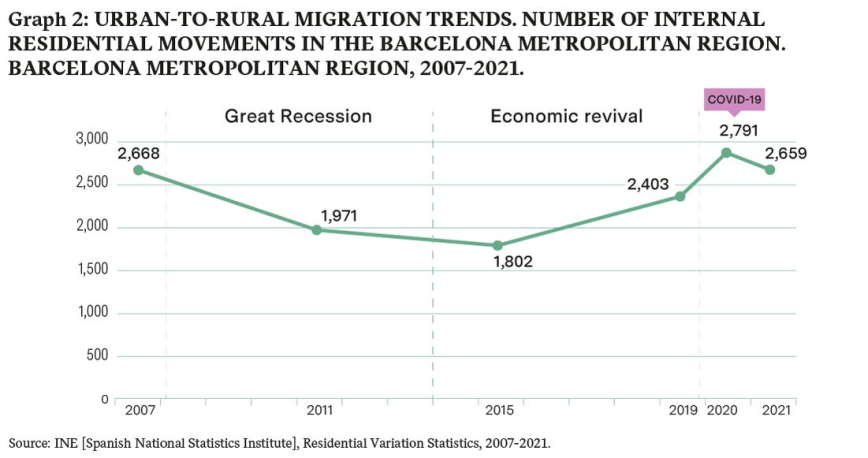
The population making these changes are native residents (88.5%), with an average age of 36. Nearly half of the population leaving the city to settle in semi-dense and rural areas does so primarily to improve their housing or residential surroundings, comprising 47.3% (graph 3).
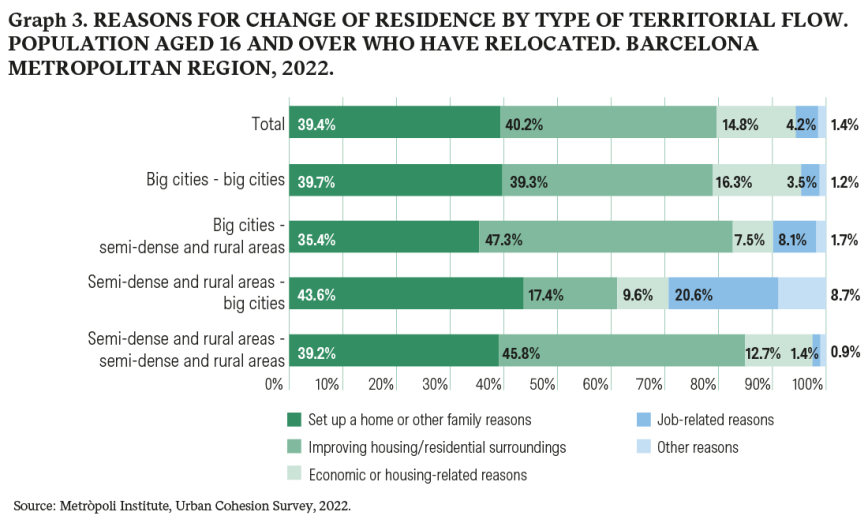
Living outside the city
Satisfaction with housing and the residential surroundings among those residing in semi-dense and rural areas of the Barcelona metropolitan region surpasses that of their counterparts in big cities. However, residing in rural municipalities entails less accessibility to services and amenities (graph 4). Nevertheless, users generally rate services and amenities positively across all levels of urbanisation. Among residents in semi-dense and rural areas, public transportation is the sole service receiving negative appraisals, highlighting significant disparities compared to urban areas, particularly the municipality of Barcelona.
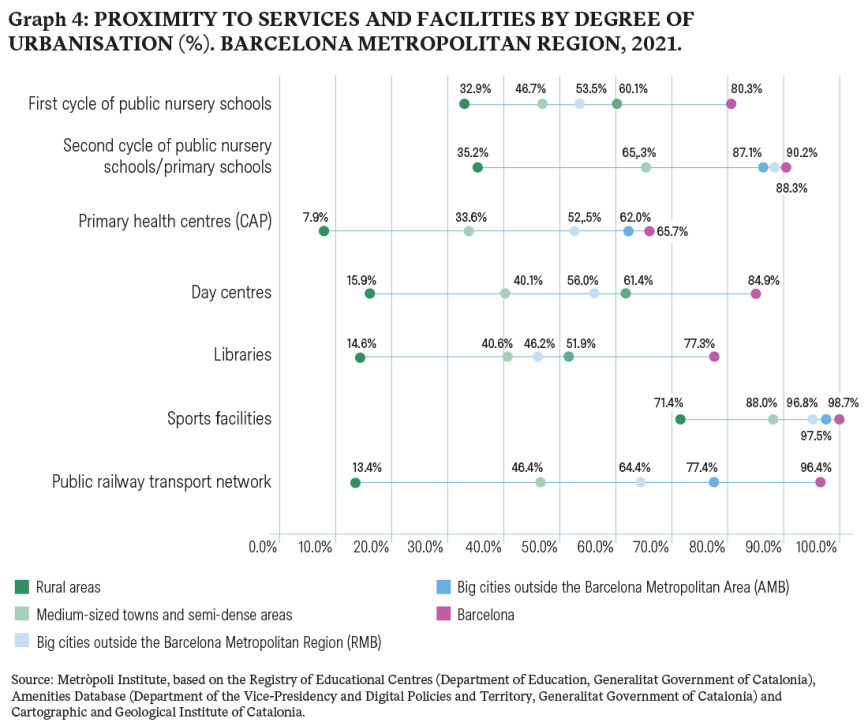
Paradoxically, despite the pronounced mobility needs of residents in rural areas, there is a shortage of public transport services. Generally, activities in these areas are more dispersed compared to big cities, with the majority taking place outside the municipality of residence. The most prominent activity, owing to its daily occurrence, is work. In semi-dense and rural areas around Barcelona, two-thirds of the populace commute to neighbouring municipalities within the Barcelona metropolitan region for work, leaving only 24.3% to work in their own residential areas (see graph 5). This starkly contrasts with the central city, where nearly eight out of ten workers are employed within the municipality they reside in.
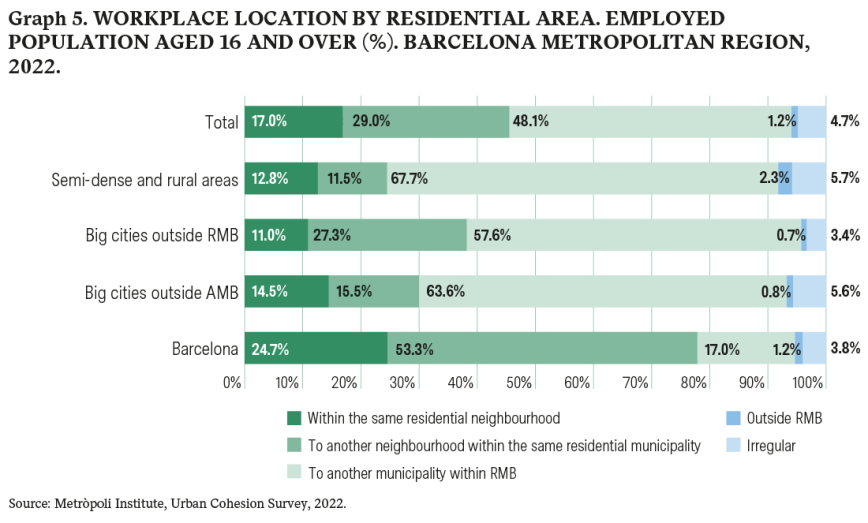
Opportunities and risks of counterurbanisation
The rising trend of urban-to-rural migration offers a chance to breathe new life into specific rural regions, particularly those in close proximity to urban hubs, often boasting robust rail networks or expressways. Yet, at present, they do not suffice as a solution to rural depopulation. Furthermore, these migrations carry a series of risks that warrant attention.
Firstly, it is imperative to gain a better understanding of the impact that the influx of urban populations may have, or could potentially have, on rural areas. This includes examining housing prices as well as potential conflicts or clashes of interests that may arise between newcomers and local residents. Secondly, the data underscores concerns regarding the possible transformation of these rural areas into commuter towns, which could contribute to an unsustainable daily mobility model. In this regard, decentralising economic and cultural activities, improving public and collective transportation services in rural areas and increasing the use of telecommuting – where feasible – are crucial aspects for supporting this urban-to-rural residential flow, particularly if it gains momentum in the coming years.
[1] González-Leonardo, M., Rowe, F. and Fresolone-Caparrós, A. “Rural revival? The rise in internal migration to rural areas during the COVID-19 pandemic. Who moved and Where?”. Journal of Rural Studies, 96, 332-342. 2022.
[2] Berry, B. J. L. “Urbanization and Counterurbanization in the United States”. The Annals of the American Academy of Political and Social Science, 451, 13-20. 1980.
[3] Karsten, L. “Counterurbanisation: why settled families move out of the city again”. Journal of Housing and the Built Environment, 35(2), 429-442. 2020.
[4] Nogué, J. “El reencuentro con el lugar: nuevas ruralidades, nuevos paisajes y cambio de paradigma”. Documents d’Anàlisi Geogràfica [Reconnecting with Place: New Ruralities, New Landscapes and Paradigm Shift”. Documents of Geographic Analysis], 62(3), 489-502. 2016.
[5] Hochstenbach, C. and Musterd, S. “Gentrification and the suburbanization of poverty: changing urban geographies through boom and bust periods”. Urban Geography, 39(1), 26-53. 2018.
[6] These findings are from the study “Rural-Urbà: migracions, entorn residencial i estructures d’oportunitat” [Rural and Urban: Migrations, Residential Environment and Opportunity Structures], carried out by the Metròpoli Institute and supported by the Strategic Metropolitan Plan of Barcelona (PEMB), the Association of Rural Initiatives of Catalonia (ARCA) and the Catalan Association of Municipalities (ACM).
The newsletter
Subscribe to our newsletter to keep up to date with Barcelona Metròpolis' new developments





